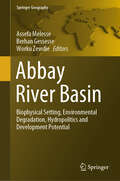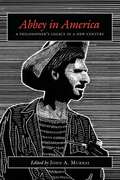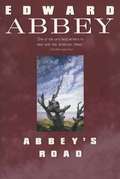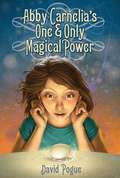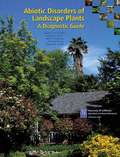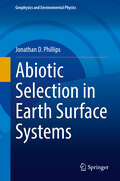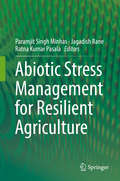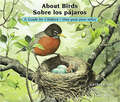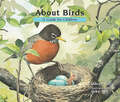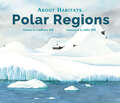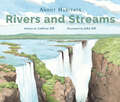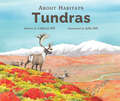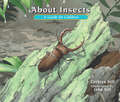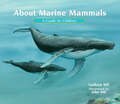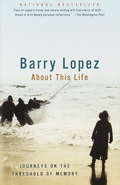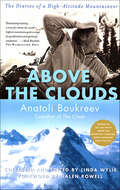- Table View
- List View
Abbay River Basin: Biophysical Setting, Environmental Degradation, Hydropolitics and Development Potential (Springer Geography)
by Assefa Melesse Berhan Gessesse Worku ZewdieThe book focuses on the Abbay Basin biophysical setting, the status of natural resources and degradation processes, agricultural practices, environmental resource conservation efforts, and the role of Earth observation and geospatial technologies in monitoring and planning for the wise utilization of natural resources under severe land resource degradation and climate change. It provides a collection of techniques and syntheses from the perspectives of geospatial science and technology application dimensions as well as legal and sociopolitical circumstances. It utilizes comprehensive data, algorithms, methods, and tools to produce and disseminate high-quality information for the Abbay Basin. It also produces empirical data and knowledge on what has been done thus far regarding the application of EO data and geospatial technologies for sustainable utilization of natural resources in the Abbay Basin and synthesizes previous studies to develop strong and consolidated information on the basin. The book will also have distinct outlooks on the purpose and contribution of satellite imagery and geospatial data as well as improved analytics for basin-wide resource management.
Abbey in America: A Philosopher's Legacy in a New Century
by John A. MurrayMore than twenty-five years after his death, iconic writer and nature activist Edward Abbey (1929–1989) remains an influential presence in the American environmental movement. Abbey&’s best known works continue to be widely read and inspire discourse on the key issues facing contemporary American society, particularly with respect to urbanization and technology. Abbey in America, published forty years after Abbey&’s popular novel The Monkey Wrench Gang, features an all-star list of contributors, including journalists, authors, scholars, and two of Abbey&’s best friends as they explore Abbey&’s ideas and legacy through their unique literary, personal, and scholarly perspectives.
Abbey's Road
by Edward AbbeAbbey's explorations include the territory of the Rio Grande in Texas, Canyonlands National Park and Lake Powell in Utah. He takes readers to such varied places as Scotland, the interior of Australia, the Sierra Madre, and Isla de la Sombra in Mexico.
Abby Carnelia's One And Only Magical Power
by David Pogue Antonio Javier CaparóTech personality Pogue delivers a whimsical debut novel about silly magical powers and kids on the run.
Abiayalan Pluriverses: Bridging Indigenous Studies and Hispanic Studies
by Gloria ChacónAbiayalan Pluriverses: Bridging Indigenous Studies and Hispanic Studies looks for pathways that better connect two often siloed disciplines. This edited collection brings together different disciplinary experiences and perspectives to this objective, weaving together researchers, artists, instructors, and authors who have found ways of bridging Indigenous and Hispanic studies through trans-Indigenous reading methods, intercultural dialogues, and reflections on translation and epistemology. Each chapter brings rich context that bears on some aspect of the Indigenous Americas and its crossroads with Hispanic studies, from Canada to Chile. Such a hemispheric and interdisciplinary approach offers innovative and significant means of challenging the coloniality of Hispanic studies.
Abiotic Disorders of Landscape Plants: A Diagnostic Guide
by Laurence R. Costello Edward J. Perry Nelda P. Matheny J. Michael Henry Pamela M. GeiselLandscape plants can be injured by biotic and abiotic agents. This book focuses on abiotic disorders such as water deficits, aeration deficits, nutritional deficiencies, specific ion toxicities, pH-related problems, and herbicide injury.
Abiotic Selection in Earth Surface Systems (Geophysics and Environmental Physics)
by Jonathan D. PhillipsThis book is about abiotic selection in Earth surface systems. It demonstrates that seemingly purposeful or goal-oriented phenomena in Earth's processes actually emerge from selection dynamics. While many think of selection in the context of biological evolution, it extends to abiotic processes crucial in understanding Earth's function and evolution. The author delineates four forms of geophysical selection: gradient, resistance, network, and thermodynamic. These selections manifest in various natural systems, from fluid flows shaping landscapes to the efficient transport of mass and energy. The book acknowledges the interplay of geophysical and ecological processes, employing them as pedagogical tools. Structured with an introduction to abiotic selection and its context, the book delves into the application of key principles—such as thermodynamics and flow dynamics—to Earth surface systems. Each subsequent chapter examines one of the four types of selection, featuring diverse real-world examples from climate dynamics to oceanography. Geared toward researchers, graduate students, and practitioners in fields such as geophysics, geology, geography, hydrology, and ecosystem sciences, it also appeals to those interested in evolutionary thinking beyond traditional life sciences.
Abiotic Stress Management for Resilient Agriculture
by Paramjit Singh Minhas Jagadish Rane Ratna Kumar PasalaThis book offers a state-of-the-art overview of on abiotic stresses in terms of the challenges; scope and opportunities; copping strategies for adaptation and mitigation using novel tools for building resilience in agricultural crops and livestock; as well as for policy implementation. Divided into four major parts: advances and prospects for understanding stress environments; adaptation and mitigation options; crop-based mitigation strategies; and mitigation options in animal husbandry, the book focuses on problem-solving approaches and techniques that are essential for the medium to long-term sustainability of agricultural production systems The synthesis and integration of knowledge and experiences of specialists from different disciplines offers new perspectives in the versatile field of abiotic stress management, and as such is useful for various stakeholders, including agricultural students, scientists, environmentalists, policymakers, and social scientists.
About Birds / Sobre los pájaros: A Guide for Children / Una guía para niños (About. . . #17)
by Cathryn SillAn award-winning, educator-approved first book on birds.In this simple volume, educator and author Cathryn Sill uses clear, easy-to-understand language to teach children what birds are, what they do, and how they live. Noted wildlife illustrator John Sill provides beautifully detailed, realistic paintings to showcase the birds' diverse and natural worlds, and an afterword provides more details about each bird and inspires further learning.
About Birds: A Guide for Children (About. . . #1)
by Cathryn SillAn award-winning, educator-approved first book on birds.In this simple volume, educator and author Cathryn Sill uses clear, easy-to-understand language to teach children what birds are, what they do, and how they live. Noted wildlife illustrator John Sill provides beautifully detailed, realistic paintings to showcase the birds' diverse and natural worlds, and an afterword provides more details about each bird and inspires further learning.
About Habitats: Coral Reefs (About Habitats)
by Cathryn SillThis beginner&’s guide introduces coral reefs to young learners (PK-2) and showcases the diversity of wildlife found around the world in these complex ecosystemsABOUT HABITATS: CORAL REEFS is an engaging first glimpse into this unique habitat. In simple terms, author and former teacher Cathryn Sill explains what corals are and how reefs are built, describes the characteristics of some of the world&’s major coral reefs, and highlights some of the many species of animals and plants that have adapted to life in these fragile environments. Detailed illustrations by award-winning wildlife artist John Sill depict a variety of coral reefs, from the Great Barrier Reef in the Pacific Ocean to the Red Sea Reef in the Indian Ocean. The colorful, detailed paintings bring the coral reefs to life for young naturalists.A map, an afterword, and a glossary provide more detailed information about coral reefs in general and about the wildlife featured in the illustrations.
About Habitats: Polar Regions (About Habitats #7)
by Cathryn SillThis beginner's guide and classroom favorite explores the Arctic and Antarctic biomes, their beauty, and global diversity. Author and former early education teacher Cathryn Sill uses simple, easy-to-understand language to teach children what the Polar Regions are—from the frozen deserts of Antarctica to the ice floes of the Arctic Ocean—along with what kinds of animals and plants live there, how they have adapted to life in this environment, and why they're important. Noted wildlife illustrator John Sill offers full-color illustrations depicting the various landscapes and species of animals and plants. A glossary and afterword provide more details for further study. Great for early childhood and elementary units on geography and habitats, nature and environment.
About Habitats: Rivers and Streams
by Cathryn SillA perfect entry for first conversations about waterways and conservation.Author and illustrator team Cathryn and John Sill offer an accessible introduction to rivers and streams, touching on their major attributes, the animals and plants that live there, and their remarkable global diversity. Using simple, easy-to-understand language, the author teaches children what rivers and streams are and explains how various species of animals and plants have adapted to life in or along these waterways. Detailed, full-color art shows the characteristics of the world's different rivers and streams―from the mountain brooks of the Alps to the mighty Amazon River in South America. A glossary and afterword provide further details. Great for casual exploration and for early childhood and elementary education units on nature, environment, earth sciences, and ecosystems.
About Habitats: Tundras (About Habitats #10)
by Cathryn SillThis beginner's guide to tundras explores the unique attributes of this cold habitat, showcasing its beauty and plant and animal diversity. Author and educator Cathryn Sill uses simple, easy-to-understand language to teach children what tundras are, what kinds of animals and plants live there, and how certain species have adapted to the unique environment. The book covers the characteristics of Arctic, Antarctic, and alpine tundras. John Sill's detailed, realistic paintings reflect the beauty and diversity of the habitat. A glossary and afterword provide more detail for further exploration. Ideal for early childhood and elementary education units on biomes and environments, geography, habitats, and nature.
About Insects / Sobre los insectos: A Guide for Children / Una guía para niños (About. . . #18)
by Cathryn SillThis beginner's guide to insects is a must-have for bug-obsessed young learners as well as for those who are simply curious about these creatures. In this addition to the acclaimed About... series, author and educator Cathryn Sill uses simple, easy-to-understand language to teach children what insects are, how they look, how they move, what they eat, and where they live. With beautifully detailed, realistic paintings, noted wildlife illustrator John Sill introduces readers to a wide variety of insects, from ants and beetles to grasshoppers and the monarch butterfly. An afterword provides further details, inspiring young readers to learn more.
About Insects: A Guide for Children (About. . . #4)
by Cathryn SillThis beginner's guide to insects is a must-have for bug-obsessed young learners as well as for those who are simply curious about these creatures. In this addition to the acclaimed About... series, author and educator Cathryn Sill uses simple, easy-to-understand language to teach children what insects are, how they look, how they move, what they eat, and where they live. With beautifully detailed, realistic paintings, noted wildlife illustrator John Sill introduces readers to a wide variety of insects, from ants and beetles to grasshoppers and the monarch butterfly. An afterword provides further details, inspiring young readers to learn more.
About Mammals / Sobre los mamíferos: A Guide for Children / Una guía para niños (About. . . #15)
by Cathryn SillAn award-winning first glimpse into the diverse natural world of mammals.This addition to the acclaimed About... series explains to children in simple, easy-to-understand language what mammals are, what they eat, and where they live. Beautifully detailed, realistic paintings by wildlife illustrator John Sill introduce readers to the huge variety of mammals, from the tiny white-footed deermouse to the large American bison. An afterword provides more details about the animals featured in the book. Parents and pre-school and primary-grade teachers will find this an attractive choice for introducing kids to mammals.
About Mammals: A Guide for Children (About. . . #2)
by Cathryn SillAn award-winning first glimpse into the diverse natural world of mammals.This addition to the acclaimed About... series explains to children in simple, easy-to-understand language what mammals are, what they eat, and where they live. Beautifully detailed, realistic paintings by wildlife illustrator John Sill introduce readers to the huge variety of mammals, from the tiny white-footed deermouse to the large American bison. An afterword provides more details about the animals featured in the book. Parents and pre-school and primary-grade teachers will find this an attractive choice for introducing kids to mammals.
About Mammals: A Guide for Children (Fountas & Pinnell LLI Blue #Level J)
by Cathryn Sill John SillThis beginner’s guide offers a first glimpse into the diverse and natural world of mammals. In this addition to the acclaimed About… series, educator and author Cathryn Sill uses simple, easy-to-understand language to teach children what mammals are, what they eat, and where they live. With beautifully detailed, realistic paintings, noted wildlife illustrator John Sill introduces readers to the huge variety of mammals, from the tiny White-footed Deermouse to the large American Bison. An afterword provides details on the animals featured and inspires readers to learn more.
About Marine Mammals: A Guide for Children (About. . . #19)
by Cathryn SillA classroom favorite, this book provides a first glimpse of marine mammals that's ideal for budding oceanographers!In this beginner's guide, author and educator Cathryn Sill simply and clearly shows children what is essential for understanding and appreciating marine mammals—how they look, how they move, what they eat, and where they live. She covers animals as diverse as whales and otters to dolphins, polar bears, and more. The beautifully detailed, realistic paintings of noted wildlife illustrator John Sill depict a variety of marine mammals. An afterword provides more details for further exploration.
About Parrots: A Guide for Children (About. . . #16)
by Cathryn SillA beautiful, informative first glance at the world of parrots.In this addition to the acclaimed About... series, author and educator Cathryn Sill uses simple, easy-to-understand language to teach children what parrots are, what they do, and how they live. With beautifully detailed, realistic paintings, noted wildlife illustrator John Sill introduces readers to the diverse population of parrots—from the colorful blue lorikeets of the Polynesian Islands to the rosy-faced lovebirds of southwestern Africa. An afterword provides more details for further exploration.
About Penguins: A Guide for Children (Fountas & Pinnell LLI Blue #Level J)
by Cathryn Sill John SillThis beginner’s guide offers a first glimpse into the natural world of penguins. In this addition to the acclaimed About… series, educator and author Cathryn Sill uses simple, easy-to-understand language to teach children what penguins are, how they look, how they move, what they eat, and where they live. With beautifully detailed, realistic paintings, noted wildlife illustrator John Sill introduces readers to a variety of penguins, from the Adélie to the Rockhopper to the Emperor. An afterword provides details on the animals featured and inspires young readers to learn more.
About This Life: Journeys on the Threshold of Memory
by Barry LopezThe acclaimed National Book Award winner gives us a collection of spellbinding new essays that, read together, form a jigsaw-puzzle portrait of an extraordinary man. With the publication of his best-selling Of Wolves and Men, and with the astonishing originality of Arctic Dreams, Barry Lopez established himself as that rare writer whose every book is an event, for both critics and his devoted readership. Now, in About This Life, he takes us on a literal and figurative journey across the terrain of autobiography, assembling essays of great wisdom and insight. Here is far-flung travel (the beauty of remote Hokkaido Island, the over-explored Galápagos, enigmatic Bonaire); a naturalist's contention (Why does our society inevitably strip political power from people with intimate knowledge of the land small-scale farmers, Native Americans, Eskimos, cowboys?); and pure adventure (a dizzying series of around-the-world journeys with air freight everything from penguins to pianos). And here, too, are seven exquisite memory pieces hauntingly lyrical yet unsentimental recollections that represent Lopez's most personal work to date, and which will be read as classics of the personal essay for years to come.In writing about nature and people from around the world, by exploring the questions of our age, and, above all, by sharing a new openness about himself, Barry Lopez gives us a book that is at once vastly erudite yet intimate: a magically written and provocative work by a major American writer at the top of his form.From the Hardcover edition.
Above the Clouds: How I Carved My Own Path to the Top of the World
by Kilian Jornet"Kilian Jornet is the most dominating endurance athlete of his generation."—NEW YORK TIMES"Inspiring and humbling"— ALEX HONNOLDThe most accomplished mountain runner of all time contemplates his record-breaking climbs of Mount Everest in this profound memoir—an intellectual and spiritual journey that moves from the earth’s highest peak to the soul’s deepest reaches.Kilian Jornet has broken nearly every mountaineering record in the world and twice been named National Geographic Adventurer of the Year. In 2018 he summitted Mount Everest twice in one week—without the help of bottled oxygen or ropes.As he recounts a life spent studying and ascending the greatest peaks on earth, Jornet ruminates on what he has found in nature—simplicity, freedom, and spiritual joy—and offers a poetic yet clearheaded assessment of his relationship to the mountain . . . at times his opponent, at others, his greatest inspiration.
Above the Clouds: The Diaries of a High-Altitude Mountaineer
by Anatoli BoukreevA breathtaking and lavishly illustrated autobiography in essays on Anatoli Boukreev, the late world-famous mountaineer and author of The Climb.When Anatoli Boukreev died on the slopes of Annapurna on Christmas day, 1997, the world lost one of the greatest adventurers of our time.In Above the Clouds, both the man and his incredible climbs on Mt. McKinley, K2, Makalu, Manaslu, and Everest-including his diary entries on the infamous 1996 disaster, written shortly after his return-are immortalized. There also are minute technical details about the skill of mountain climbing, as well as personal reflections on what life means to someone who risks it every day. Fully illustrated with gorgeous color photos, Above the Clouds is a unique and breathtaking look at the world from its most remote peaks.
